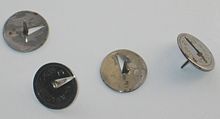

A tack piano (also known as a harpsipiano, jangle piano, and junk piano) is an altered version of an ordinary piano, in which objects such as thumbtacks or nails are placed on the felt-padded hammers of the instrument at the point where the hammers hit the strings, giving the instrument a tinny, more percussive sound. It is used to evoke the feeling of a honky-tonk piano. [1]
Tack pianos are commonly associated with ragtime pieces, often appearing in Hollywood Western saloon scenes featuring old upright pianos. [2] The instrument was originally used for classical music performances as a substitute for a harpsichord. [3]